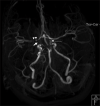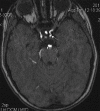Internal carotid artery origin of the anterior cerebral artery: A rare anatomic intracranial arterial variation in a child with morning glory disc anomaly and moyamoya vascular pattern; case report and review of literature
- PMID: 33033785
- PMCID: PMC7511914
- DOI: 10.4103/bc.bc_10_20
Internal carotid artery origin of the anterior cerebral artery: A rare anatomic intracranial arterial variation in a child with morning glory disc anomaly and moyamoya vascular pattern; case report and review of literature
Abstract
Morning glory disc anomaly (MGDA) characterizes a congenital dysgenetic disorder of the optic disc, coexisting with arterial intracranial abnormalities, including Moyamoya vascular disease, a significantly rare disease in the European populations. We report a 2.5-year-old female child from Greece previously diagnosed with MGDA, who presented with right-hand paresis, accompanied by focal epileptic spasms, followed by an episode of brief absence seizure, as well as some arm clonic spasms. Magnetic resonance angiography scan revealed the presence of an anomalous origin of the anterior cerebral artery (ACA) from the internal carotid artery (ICA) along with vascular abnormalities, compatible with Moyamoya pattern. To the very best of our knowledge, this is the first reported case of anomalous origin of ACA from the supraclinoid ICA accompanied by severe occlusive intracranial disease (moyamoya-like pattern) in a patient with known MGDA, highlighting the embryonic character of the vascular manifestations in MGDA. It also verifies the association of Moyamoya pattern with MGDA, thus linking vascular dysgenesis as a possible cause of MGDA.
Keywords: Cerebral arterial diseases; intracranial arterial diseases; morning glory disc anomaly; moyamoya disease; moyamoya vascular pattern.
Copyright: © 2020 Brain Circulation.
Conflict of interest statement
There are no conflicts of interest.
Figures




Similar articles
-
Morning glory disc anomaly associated with moyamoya disease and pituitary stalk duplication.Am J Ophthalmol Case Rep. 2022 Jun 24;27:101632. doi: 10.1016/j.ajoc.2022.101632. eCollection 2022 Sep. Am J Ophthalmol Case Rep. 2022. PMID: 35813587 Free PMC article.
-
Morning glory disk anomaly, choroidal coloboma, and congenital constrictive malformations of the internal carotid arteries (moyamoya disease).Ophthalmic Genet. 2000 Mar;21(1):21-4. Ophthalmic Genet. 2000. PMID: 10779846
-
Morning glory syndrome with Moyamoya disease: A rare association with role of imaging.Indian J Radiol Imaging. 2018 Apr-Jun;28(2):165-168. doi: 10.4103/ijri.IJRI_219_17. Indian J Radiol Imaging. 2018. PMID: 30050238 Free PMC article.
-
Moyamoya Disease Associated With Morning Glory Disc Anomaly and Other Ophthalmic Findings: A Mini-Review.Front Neurol. 2020 May 15;11:338. doi: 10.3389/fneur.2020.00338. eCollection 2020. Front Neurol. 2020. PMID: 32499749 Free PMC article. Review.
-
[A case of adult moyamoya disease showing fulminant clinical course associated with progression from unilateral to bilateral involvement].No Shinkei Geka. 1997 Jan;25(1):79-84. No Shinkei Geka. 1997. PMID: 8990473 Review. Japanese.
Cited by
-
Vitrectomy Combined With Gas Tamponade for the Treatment of Morning Glory Syndrome With Rhegmatogenous Retinal Detachment: A Case Report.Cureus. 2025 Feb 5;17(2):e78550. doi: 10.7759/cureus.78550. eCollection 2025 Feb. Cureus. 2025. PMID: 40062134 Free PMC article.
References
-
- Lee BJ, Traboulsi EI. Update on the morning glory disc anomaly. Ophthalmic Genet. 2008;29:47–52. - PubMed
-
- Scott RM, Smith ER. Moyamoya disease and moyamoya syndrome. N Engl J Med. 2009;360:1226–37. - PubMed
-
- Hever P, Alamri A, Tolias C. Moyamoya angiopathy – Is there a Western phenotype? Br J Neurosurg. 2015;29:765–71. - PubMed
-
- Kindler P. Morning glory syndrome: Unusual congenital optic disk anomaly. Am J Ophthalmol. 1970;69:376–84. - PubMed
Publication types
LinkOut - more resources
Full Text Sources
Miscellaneous
